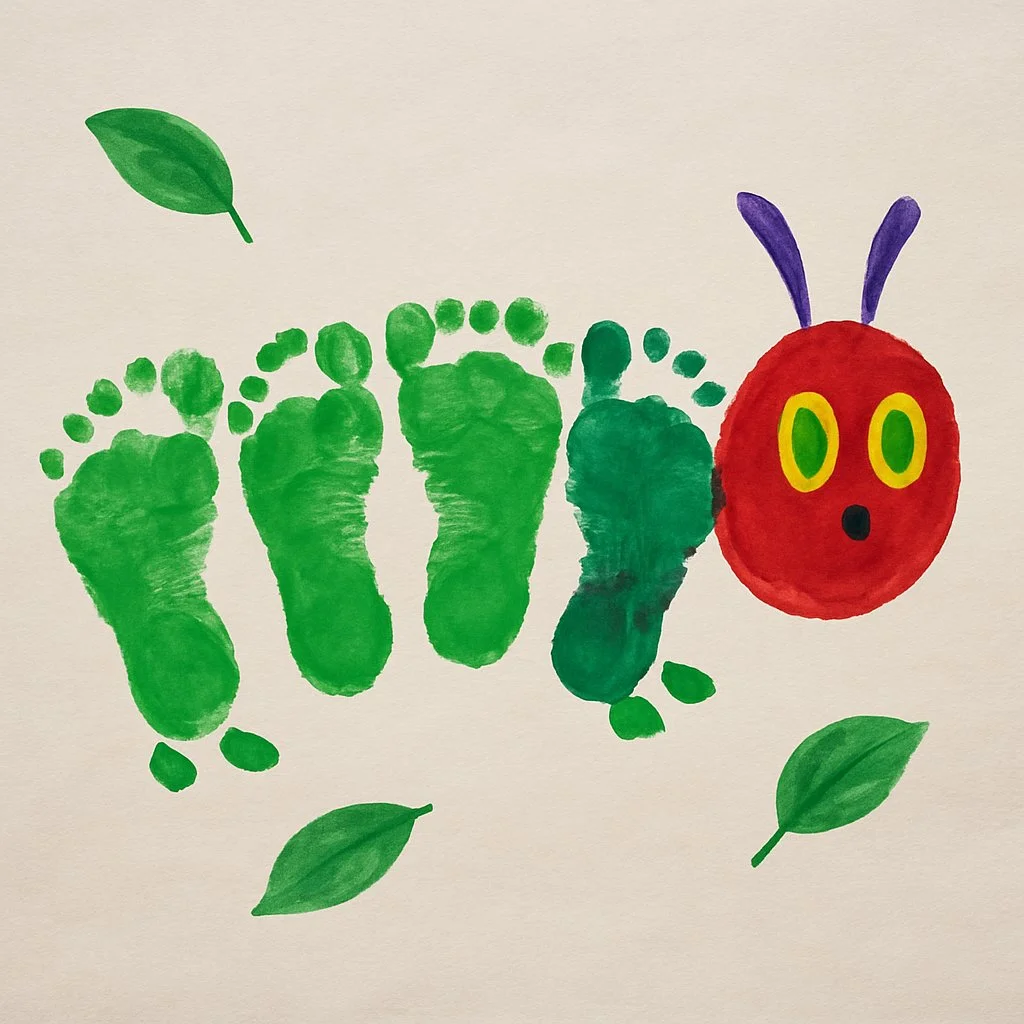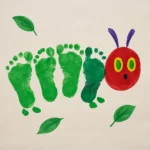Creating Very Hungry Caterpillar Footprint Art is a delightful and engaging activity that captures the imagination of little ones. My kids had so much fun with this project on a rainy afternoon; they couldn’t stop talking about the caterpillar they created with their own feet! This art activity combines creativity with a bit of a mess, making it a memorable experience for both kids and parents. It’s an excellent way to bring Eric Carle’s beloved story to life while encouraging kids to express themselves artistically.

Why Make This Activity
Engaging in Very Hungry Caterpillar Footprint Art offers numerous benefits. Firstly, it nurtures creativity by allowing children to design and personalize their artwork. Secondly, it promotes sensory play as kids feel different paint textures and the sensation of their feet on the paper. Additionally, it helps develop fine motor skills as children use their hands to manipulate brushes and dab paint. This activity also fosters interactive play, making it perfect for siblings or classmates.
You can introduce this project at birthday parties, school art days, or simply as a fun home activity. The joyful experience and collaborative nature of creating footprint art make it an entertaining learning journey for kids.
How to Make Very Hungry Caterpillar Footprint Art
This engaging art project involves kids using their feet to create a caterpillar design. The goal is to create a visual representation of the caterpillar, inspired by Eric Carle’s classic character. Before getting started, it’s essential to ensure that adult supervision is present, especially with young children, to aid in safety and cleanup.
Materials Needed:
- Washable tempera paint (green, red, yellow, purple)
- Large sheet of white construction paper or canvas
- Paper towels or washcloths for cleanup
- Plastic tray or plate for paint
- Aprons or old t-shirts to protect clothing
- A sponge or paintbrush for adding details (optional)
Steps:
- Set up your workspace by laying down newspaper or a plastic covering to catch any spills.
- Pour the washable tempera paint onto a plastic tray or plate. Use green for the caterpillar’s body and red or yellow for the head.
- Help your child put on an apron or old t-shirt to protect their clothing.
- Have the child step into the green paint, ensuring their entire foot is covered.
- Instruct them to press their foot down on the construction paper, creating the caterpillar’s body. Make several foot prints in a row to form the body.
- Clean the child’s foot with a washcloth or paper towel, then repeat the process with the red or yellow paint for the caterpillar’s head.
- Allow the footprints to dry completely before adding any additional details or decorations with paintbrushes or sponges.
- Once dry, encourage your child to decorate their caterpillar with googly eyes, additional colors, or even by drawing leaves around it.
How to Use or Play With Very Hungry Caterpillar Footprint Art
Kids can proudly display their Very Hungry Caterpillar Footprint Art on the refrigerator or a gallery wall in your home. To enhance the educational aspect, you can engage in storytelling by reading the book, discussing each food the caterpillar eats, or even creating a mini puppet show with their art as the backdrop. This interaction fosters imaginative play and can lead to discussions about the life cycle of butterflies or healthy eating habits.
How to Store or Reuse Very Hungry Caterpillar Footprint Art
If you’d like to keep the artwork, ensure it has completely dried, and store it flat in a large, clean envelope or folder to prevent bending or rippling. The footprint art can generally last for months, though it’s advisable to keep it away from direct sunlight to avoid fading. If you wish to freshen it up, you can always take a photo of it and create new art as seasons change.
Tips to Make Very Hungry Caterpillar Footprint Art Successful
- Supervise Carefully: Ensure constant supervision to help children navigate the paint and messy process.
- Choose the Right Paint: Opt for washable tempera paint to make cleanup easier and minimize stress about stains.
- Prepare a Cleanup Station: Keep paper towels and a wet washcloth nearby to quickly assist in cleanup.
- Engage Different Ages: For younger kids, simplify the activity by just having them step in the paint, while older children can focus on adding details.
- Create Space: Lay down extra newspaper to give plenty of space for kids to move around while creating their footprint art.
What to Avoid When Making or Using Very Hungry Caterpillar Footprint Art
- Skipping the Cleanup Step: Don’t skip cleaning kids’ feet between colors; it can lead to muddy results and frustration.
- Using Non-Washable Paints: Avoid using paints that are not washable, as they can cause permanent stains on clothes and surfaces.
- Overcomplicating the Process: Keep the steps simple, as young kids may lose interest if the process seems overwhelming or lengthy.
Possible Variations
- Seasonal Themes: Adapt the activity to the seasons by making footprint art of fall leaves, snowflakes, or spring flowers.
- Group Projects: Collaborate as a group to create a massive caterpillar mural, where each child contributes a section.
- Change the Creature: Instead of a caterpillar, kids can create other characters like butterflies or ladybugs using their footprints.
FAQs
1. What age range is this activity suitable for?
This footprint art activity is suitable for children ages 2 and up. Younger children can enjoy the sensory experience of the paint and the fun of making footprints, while older kids can engage in more detailed art creation and storytelling. Always ensure there is adult supervision, especially with toddlers who may put paint in their mouths.
2. How can I manage the mess during this activity?
Managing mess is key to enjoying this art project! Use a large plastic covering or old newspaper under the workspace to catch spills. Designate a cleanup area with wet wipes or towels nearby. Dress kids in old clothes or large t-shirts to protect their outfits. Opting for washable tempera paint also simplifies the mess management afterward.
3. What if I don’t have the exact materials?
If you lack washable tempera paint, you can use any water-based paint or even food coloring mixed with water. Construction paper can be substituted with old cardboard or even a blank canvas if available. Encourage creativity in using whatever safe materials you have at home to encourage imaginative expression!
Conclusion
Creating Very Hungry Caterpillar Footprint Art is not just about making art; it’s about creating cherished memories with your children. This activity invites creativity, sensory experiences, and a great deal of fun, making it a worthwhile endeavor that can be repeated time and again. I encourage you to give it a try and share this creative journey with friends or family – you’ll be amazed at what wonderful artwork your little ones can create!

Very Hungry Caterpillar Footprint Art
Ingredients
Materials Needed
- 1 bottle Washable tempera paint (green, red, yellow, purple) Choose washable paints for easy cleanup.
- 1 sheet Large sheet of white construction paper or canvas This will be the canvas for the footprint art.
- 1 roll Paper towels or washcloths for cleanup Keep nearby for easy cleanup.
- 1 plate Plastic tray or plate for paint Use this to hold the paint.
- 1 each Aprons or old t-shirts Protect clothing from paint.
- 1 each A sponge or paintbrush (optional) For adding additional details.
Instructions
Setup
- Lay down newspaper or a plastic covering to catch any spills.
- Pour the washable tempera paint onto a plastic tray or plate, using green for the caterpillar’s body and red or yellow for the head.
- Help your child put on an apron or old t-shirt to protect their clothing.
Creating the Caterpillar
- Have the child step into the green paint, ensuring their entire foot is covered.
- Instruct them to press their foot down on the construction paper, creating the caterpillar’s body, making several footprints in a row.
- Clean the child’s foot with a washcloth or paper towel, then repeat the process with the red or yellow paint for the caterpillar’s head.
Adding Details
- Allow the footprints to dry completely before adding details or decorations with paintbrushes or sponges.
- Encourage your child to decorate their caterpillar with googly eyes and additional colors.
